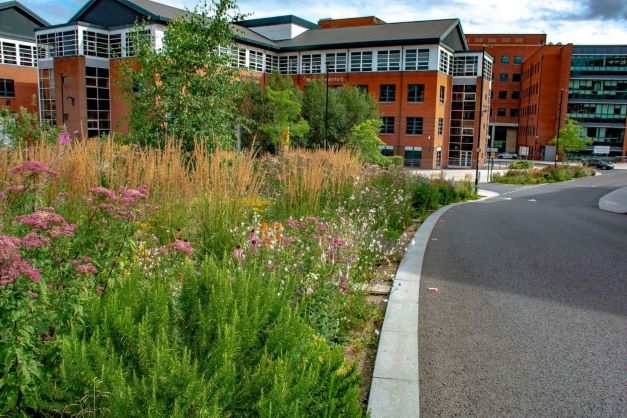Considering Weed Prevention when Greening our Urban Environments
It is fantastic to see some innovative projects to make our urban spaces greener. However, as we try to reduce our reliance on chemical pesticides it is important to consider weed prevention.
Weeds and rewilding our cities
It is fantastic to see some innovative projects to make our urban spaces greener. This is not only beneficial for the environment; providing habitats for pollinators and other wildlife, but also our own health and wellbeing.
The Grey to Green scheme in Sheffield - the UK’s largest retro-fit SuDS project, and also the UK’s largest inner city ‘Green Street’ is a good example of what can be achieved with regards to greening our cities. Design work started in 2014, with phase 1 of the 1.6 kilometre scheme installed in 2016, and Phase 2 currently under construction.

Image from https://www.nigeldunnett.com/grey-to-green-2/
However, as we try to reduce our reliance on chemical pesticides it is important to consider weed prevention in the design of these schemes. Some simple choices with regards to planting, edging and the types of hard surfaces used can have a big impact on helping to reduce weed growth - making the hard surfaces easier to maintain without plant protection products.
Plant choices that will help prevent weeds;
To prevent weeds on the remaining hard surfaces that will need to be used by pedestrians and vehicles it is vital that we minimise the amount of organic debris, or detritus that is generated by all the vegetation. For example, it is very common to see lots of grass in urban verges that must be cut frequently - producing lots of clippings, which will get trapped on our hard surface and degrade into nutrient rich soil. This detritus and soil build up is what allows weeds to get established on a hard surface. This can be avoided by choosing more suitable plants such as ground cover like lavender, periwinkle, heather and many others, which are much easier to maintain and produce very little additional detritus. They can also make a much better habitat for pollinators.
Trees should be considered too, as they have the potential to drop a lot of leaves, which must be regularly cleared to prevent detritus and soil build up. Obviously it’s great to have variety, but there are plenty of choices that will reduce the amount of leaf fall that you will expect. Evergreen trees such as Holly or some deciduous trees less prone to dropping leaves over winter such as Beech make great choices in urban areas to help reduce the detritus and soil build up on hard surfaces.

Image from https://www.nigeldunnett.com/grey-to-green-2/
Design edges to help prevent weeds
It is easy for a verge to spill onto a hard surface, especially as more organic material gets trapped at the point where one meets the other. A raised edge between the soil and hard surface acts as a barrier to prevent migration of soil onto the hard surface. It also gives a nice line to keep vegetation pruned to and the hard surface swept up to.
Edges should avoid abrupt changes in shape that are difficult to navigate with a sweeper, as soil will build up in these neglected spots over time.
Hard surface choices to help prevent weeds
Avoid cracks and crevasses as far as possible. We want as few points on our surface where organic matter can get trapped as possible. It is therefore usually a good idea to stay away from surfaces like block paving, gravel or slabs, which have built in gaps where detritus can get trapped and provide nutrients for weeds.
If using tarmac or concrete for the surface, we should try to ensure that all cracks and points where they meet another surface (such as the edging, or a kerb) are sealed to remove these problem areas. Gravel and paved areas can be maintained mechanically if laid properly, but this should be considered carefully when specifying this type of surface.
For more information on developing an integrated Weed Management plan check out our 4 step plan. https://kerstenuk.com/Integrated-Weed-Management-&-Weed-Prevention
No comments yet. Login to start a new discussion Start a new discussion